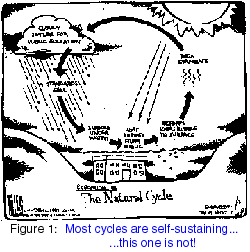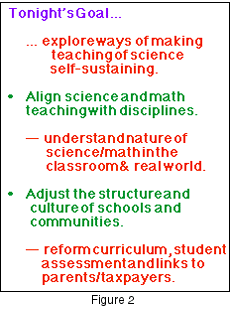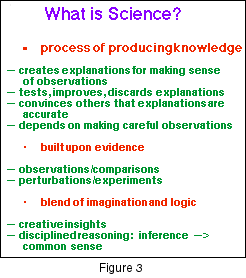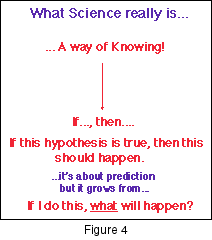|
author:
|
Daniel I. Rubenstein
|
|
published:
|
03/03/1999
|
|
posted to site:
|
03/03/1999
|
Reforming Science & Mathematics Education:
Making Inquiry Based Science Self-Sustaining
Daniel I. Rubenstein
Department of Ecology and Evolutionary Biology
Princeton University
Princeton, NJ 08544-1003
|
Welcome
Dr. Spresser: I get to do the fun part. Remember the question, where do you stop? That is one of the most important questions that you as teachers have to deal with. The second one is where do you start your investigation? Scientists intuitively know how to do this. I'm not convinced that teachers do and I certainly know that students don't. Only when both you and your students master the skill will you be able to do science. With these words, professor Dan Rubenstein begins to engage his 1989 audience at the Breadloaf Conference on Teacher Education and the Liberal Arts Colleges.
He's been in the business of talking and writing about critical thinking and the teaching of science for a long time. As a faculty member at Princeton University who teaches and researches in ecology, evolution, and behavior, he's thought deeply about matters such as the structure and values that are intrinsic to the disciplines of science. About how the scientist goes from unbridled discovery to channeled discovery. And about how this contrasts with the way students actually learn and practice science. So please join me in welcoming Dr. Dan Rubenstein.
Introduction
Thank you very much for the kind welcome. I'm delighted to be here and I thank Susan and Carlo for inviting me because it gives me the opportunity to do some of the things I like best. I truly enjoy doing my science, my teaching, and working with teachers who are dedicated to improving the teaching of science. My goal tonight is to try to examine ways in which we can reform science and mathematics education so that the process of doing science and mathematics can be self-sustaining.
My talk is going to be divided into two parts: talking about how scientists and mathematicians ‘do’ science and mathematics and then how to teach this process to students. I will also allude to the processes of assessment and the structural constraints associated with education in today’s society. In this way, I will foreshadow some of the topics you will address in more detail for the next few days.
I want to begin with a cartoon that appeared in yesterday morning's Trenton Times (Figure 1). It typifies the response that occurs when the President of the United States says in the State of the Union Address "we're going to invest more money in improving science and mathematics education in the United States." The cartoon suggests that we start out with a cloudy future for public education. Subliminally, it suggests that we're not there yet and that standards are falling. As the rain continues to fall, the schools go underwater. Heat arises from the public and reform ideas bubble to the surface, where they evaporate and get lost. It typifies the response that occurs when the President of the United States says in the State of the Union Address "we're going to invest more money in improving science and mathematics education in the United States." The cartoon suggests that we start out with a cloudy future for public education. Subliminally, it suggests that we're not there yet and that standards are falling. As the rain continues to fall, the schools go underwater. Heat arises from the public and reform ideas bubble to the surface, where they evaporate and get lost.
One of the issues I want to explore tonight is why this cynical cycle happens and how to stop it by creating one that is self-sustaining. This is a cycle in which ideas evaporate and only a "push" from outside – heat from the public – prompts it to start all over again. We want to make it self-sustaining so it can be supported through the actions of everybody from inside the loop. Inclusion will be one of the themes that I want to address tonight. At the end of the talk, we'll come back to the cartoon and relabel it so that it can be made self-sustaining.
As I alluded to earlier, my goal is simple. I want to explore ways of making the teaching of science self-sustaining. And I will do this in two ways (Figure 2) First, I'll talk about how we align science and math to the disciplines. And to do that, I'm going to share with you the understanding, as I see it, of the nature of science and mathematics as it is done in both the classroom and in the real world, where practicing scientists and mathematicians operate. I want to explore ways of making the teaching of science self-sustaining. And I will do this in two ways (Figure 2) First, I'll talk about how we align science and math to the disciplines. And to do that, I'm going to share with you the understanding, as I see it, of the nature of science and mathematics as it is done in both the classroom and in the real world, where practicing scientists and mathematicians operate.
Then I will talk briefly about connecting these ideas to the community; how we have to adjust the structure and the culture of schools and their communities to make the whole systemic effort self-sustaining. And I will very briefly talk, not about reforming curriculum, you'll hear about that tomorrow morning, but about student assessment and the links to parents and taxpayers that can help buoy the system and give it it's own self-sustaining energy. So let's begin.
The Nature of Science
In the hour before dinner, I was reading your project summaries and your projects in the deserts, in Alaska, and even in Baltimore. They're compelling. They're exciting. I want to hear more about them. I want to hear about how you are making the transformation of teaching science work in your areas. I'm privileged to be part of the executive committee of one of the projects, "E=MC2", a project which is on page 38 and some of whose people are here tonight. Therefore, I appreciate how local initiatives operate, and will include some of my experiences in tonight's presentation.
What is Science? Figure 3 highlights a long list of properties and processes that most people think of as science. First, science is really about the process of producing knowledge. But what exactly does that mean? It means we create explanations by making sense of how things happen in the world. It's also creative. Scientists come up with ideas and explanations to account for the unknown. That's what a scientist does. Scientists are fascinated by problems to which they don't know the answers. They use their minds and disciplined reasoning to solve the problem at hand. Figure 3 highlights a long list of properties and processes that most people think of as science. First, science is really about the process of producing knowledge. But what exactly does that mean? It means we create explanations by making sense of how things happen in the world. It's also creative. Scientists come up with ideas and explanations to account for the unknown. That's what a scientist does. Scientists are fascinated by problems to which they don't know the answers. They use their minds and disciplined reasoning to solve the problem at hand.
As scientists, we design tests that improve and discard explanations. We're continually picking and probing at the explanations we generate to see if they're adequate. We ask, are they accounting for all of the patterns that we see in the world? If so, then we try to convince others that our explanations are correct. That's the hard part. Even if we think we've got it right, we still have to publish the results. We have to convince reviewers that our analyses and conclusions accurately explain the patterns. We've got to convince the skeptics. Because scientists are skeptics, we have to convince others that what we're proposing as an explanation is in fact the explanation. And of course our ability to do so depends on making careful observations.
Science is also built upon evidence. It's built upon observations and comparisons, but it's also based on experiments or perturbations. We push systems. We perform experiments where we do fair tests. Most of our ideas, the evidence that we assemble, are used to test models – our hypothetical constructs about how we think the world is organized. In essence, models are caricatures of reality and most scientists build models using mathematics. Mathematics is the language of science, natural or social.
And why do we use mathematics? It's precise. Ultimately, it is a sentence with no ambiguity. It puts the relationships that we think are important in structuring our thoughts about the world precisely in front of us. It bares our assumptions so that skeptics and critics can say, "Well, maybe your explanation is true, but that assumption is too general, or unrealistic. If you relax this, or change that, then how good is your explanation? How good is your model?"
With words, we can fudge. English is a hazy language. Mathematics is not. And this is true whether the process being described is deterministic or stochastic where events themselves occur with uncertainty. And so mathematics and science go hand in hand. And it's delightful to see in the booklet the number of projects that are blending science and mathematics.
Science is also about blending imagination and logic. It is built upon creativity. Scientists play with ideas. We use everything we know about the world to give us insight and then we use disciplined processes of reasoning, derived either from common sense or based on more rigid rules of inference, to ask the right questions. And again, quantitative reasoning comes into play.
So this is what we mostly think of as science. But any list that is this long is something you are all going to forget. So I've reduced it to something simpler (Figure 4). Science is a way of knowing about how the world works. How do we use this way of knowing? We construct statements that are very simple. We use ‘if-then’ statements. That's ultimately what science is all about. What do we mean by an ‘if-then’ statement? It's as follows: But any list that is this long is something you are all going to forget. So I've reduced it to something simpler (Figure 4). Science is a way of knowing about how the world works. How do we use this way of knowing? We construct statements that are very simple. We use ‘if-then’ statements. That's ultimately what science is all about. What do we mean by an ‘if-then’ statement? It's as follows:
If this hypothesis I've just formulated is true, or this model, this caricature of reality that I believe explains the pattern that fascinates me is accurate, then this should happen. Or if I were to change x by perturbing it to y, then I'd expect the system to respond by going from A to B.
A series of ‘if-then’ relationships is what science is all about. You build a model, and once you have that model, you then predict what consequences would be expected if something is altered. Then you go out and examine whether or not the change occurred as expected. Ultimately, science is about prediction.
|

